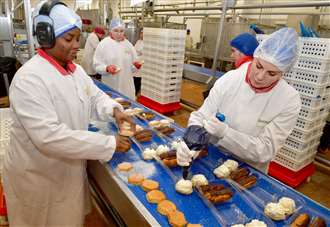
When we see desserts adorning shelves in supermarkets, we don’t often think about who or what made them. Newark is famous for many things — its castle, the National Civil War Centre, and its rich history — but did you know that Newark is home to the biggest chilled desserts factory in the world? We went to see what magic goes on behind the scenes of Bakkavor Desserts, in Jessop Way, a major supplier for several UK supermarkets, including M&S, Tesco, Sainsbury’s, Waitrose, Asda, and Morrisons. With nearly 2,000 employees, the factory is one of the most significant employers in the area and produces thousands of desserts every day, and the only time production stops is for eight hours during Christmas night.
The Newark site specialises in cream cakes, trifles and custard desserts, and makes over 300 different products annually, with around 40 seasonal dessert s added over the Christmas period. The Bakkavor Group was established in 1986 in Iceland by Agust and Lydur Gudmundsson, who over the years, expanded its footprint across the UK by acquiring various food manufacturing businesses. The Newark site’s journey began in 1993 when it was established by Lauren’s Patisserie until it was acquired by Bakkavor in 2006, beginning a series of expansions.

Upon acquisition, Bakkavor added a third and fourth bay to the facility, enhancing its production capacity. But the most substantial development came in 2019 when a £50 million investment was secured to construct a fifth bay. This expansion was aimed at increasing the site’s capabilities for choux, sponge, and egg custard tart production, while also implementing advanced automation processes.
Today, the manufacturing area spans 32,000 square meters, a testament to Bakkavor’s commitment to innovation and growth. “Automation has been a game-changer for us,” said Andrzej Szokalski, the site operations manager. “Particularly with high-demand products like choux pastries and custard tarts, where precision and speed are essential.
” The site is responsible for producing around 260 million choux products, 40 million doughnuts, 77 million custard tarts, and 46 million trifles each year. Even though Bakkavor doesn’t raise chickens, they use around 10 million eggs a year, and produce 12,000 tons of cream every year — enough to fill a couple of Olympic-sized swimming pools. The factory is split into “high care” and “low care” areas, with stringent hygiene protocols to match, each requiring wearing specialized clothing, from hairnets and warehouse coats to specific shoes and even pens.
Hand washing was a ritual — thorough and often repeated. This attention to detail in maintaining cleanliness and preventing contamination was impressive, not to mention necessary when producing fresh, chilled desserts at such a massive scale. As I toured the main factory, it was clear that everything ran with military precision.
Every team member knew their role, and it was evident how proud they were to be part of the Bakkavor team. On the bakery side of the factory, approximately 46 highly skilled employees work in a highly automated environment. However, the human eye is still very important for ensuring quality control in the desserts.
Craig Line, the factory bakery manager, said: “I’ve got to make sure everything’s running here because we have 28 production lines. “For our customers, we are like the Bakery Banksy’s of the world.” After seeing rotating ovens, learning about the desserts chilling and resting times and seeing pastries grow from dough to a sweet-smelling dessert waiting to be filled with love, we moved to another exciting part of the factory.
We were guided by James Reed, the factory manager responsible for bays four and five, which produce trifles, egg custards, and potted custards. We watched as large machines with cameras swiftly picked up egg custard tarts, before packaging them with impressive speed. The precision of the technology was incredible, but it was the combination of machines and people working together that made the whole process so impressive.
On the third part of the tour, we got to meet Dan Barry, the factory manager responsible for filling the choux desserts. We even saw how the famous eclairs get the cream inside and are covered in chocolate before going through a dry ice process to make sure that the chocolate doesn’t melt before making it to our homes. One of the lines had workers hand-filling desserts, which seemed like a daunting task, especially during a 12-hour shift but to prevent exhaustion, workers rotate tasks every hour, ensuring a steady flow and high-quality output.
Marie Bamberger joined the factory when it was still Lauren’s Patisserie and has been working with the company for nearly 30 years and said it has been amazing to see the company develop and take over so many new workers and different sections. After immersing myself in the heart of the Newark site’s busy production lines, we headed over to Sherwood House, a short distance away from the main factory. This facility serves as the creative hub for Bakkavor’s new product development team with 10 chefs and also houses its finance headquarters, which has grown from 12 to 15 people to 54 people over the past year and has become the central hub.
As I entered the panel room, I could see chefs and development managers gathered around workstations, discussing ideas, evaluating samples, and refining recipes. The new product development facility was refurbished last year, providing the team since September, with a new space to work on new products. Peter Geraghty, the senior development chef at Bakkavor has several years of experience, from working in Michelin restaurants to product development.
He said: “It's very different from working in a restaurant. We’re not working in a lunch or dinner service, but the pressures are unique. “All the concepts we design have to fit the factory’s processes, they need to be cost-effective and feasible to scale up.
“It’s a constant balancing act between creativity and practicality.” In 2024, the team launched around 150 new products, which showed their combination of creativity and technical expertise. Karen , a kitchen assistant who has been with the business for nearly 25 years, proudly pointed out the dry stores and chillers.
“I was only supposed to stay until my daughter left school, but she’s been here 17 years herself,” Karen laughed. “It’s a family, really.” Despite the cutting-edge technology and meticulously managed processes, it was clear that Bakkavor Desserts thrives on human creativity and dedication.
From the highly skilled workers on the factory floor to the inventive minds at Sherwood House, the company’s success lies in its combination of precision and passion. What surprised me most during my visit was how much creativity, collaboration, and trial-and-error go into making desserts that many of us take for granted. It isn’t just about mixing ingredients — it’s about meeting high standards set by retailers, adapting to changing trends, and creating memorable experiences through food.
Even though we have attached quite a few photos from our tour here, some of the processes and machines are yet a secret to the reader’s eye, but trust us when we say — Bakkavor is everywhere..











